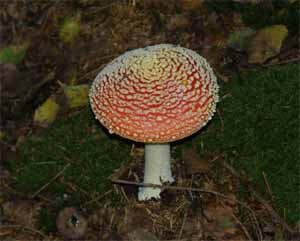- Agaricales
Taxobox
name = Agaricales

image_width = 250px
image_caption = "Amanita muscaria " (Amanitaceae )
regnum =Fungi
regnum = Fungi
subregnum =Dikarya
phylum =Basidiomycota
subphylum =Agaricomycotina
classis =Agaricomycetes
subclassis =Agaricomycetidae
ordo = Agaricales
ordo_authority = Underw., 1899 [cite book | author = Underwood, L.M. | year = 1899 | title = Moulds, mildews and mushrooms: a guide to the systematic study of the Fungi and Mycetozoa and their literature | location = New York | publisher = Henry Holt | pages = 97]
subdivision_ranks = Families
subdivision =Agaricaceae Amanitaceae Bolbitiaceae Clavariaceae Cortinariaceae Crepidotaceae Entolomataceae Fistulinaceae Hydnangiaceae Hygrophoraceae Lycoperdaceae Marasmiaceae Nidulariaceae Omphalotaceae Physalacriaceae Pleurotaceae Pluteaceae Podaxaceae Psathyrellaceae Schizophyllaceae Strophariaceae Tricholomataceae The order Agaricales, also known as gilled mushrooms (for their distinctive gills), or euagarics, contains some of the most familiar types of
mushrooms . The order has about 4,000 identifiedspecies , or one quarter of all knownAgaricomycetes . They range from the ubiquitous common mushroom to the deadly destroying angel and the hallucinogenic fly agaric to the bioluminescent jack-o-lantern mushroom.Classification
Some notable fungi with gill-like structures, such as
chanterelle s, have long been recognized as being substantially different from usual Agaricales. Interestingly, molecular studies are showing more groups of agarics as being more divergent than previously thought, such as the genera "Russula " and "Lactarius " belonging to a separate orderRussulales , and other gilled fungi, including such species as "Paxillus involutus " and "Hygrophoropsis aurantiaca " showing a closer affinity withBolete s in the orderBoletales .Also, some other quite distinctive fungi, the
puffball s, and some clavaroid fungi, e.g. "Typhula ", and the Beefsteak fungus have been recently been shown to lie within the Agaricales.The term
agaric had traditionally referred to Agaricales, which were defined as exactly those fungi with gills. Given the discoveries described above, those two categories are not synonymous (although there is a very large overlap between the two groups).Distribution and habitat
Agarics are ubiquitous, being found across all continents. Most are terrestrial, their habitats including all types of woodland and grassland, varying largely from one genus to another.
Characteristics
Basidiocarp s of the agarics are typically fleshy, with a stipe, often called a stem or stalk, apileus (or cap) andlamella e (or gills), wherebasidiospore s are produced. This is indeed the stereotyped structure of what we would call amushroom .Life cycle
The agarics' life cycle is very much representative of the basidiomycetes.
Clamp connection s are present in thedikaryon s of many species. The agarics always have their basidiospores ejected from thebasidium into the area between gill edges. The spores are then let fall to the ground or carried by the wind.References
External links
* [http://americanmushrooms.com/agarics.htm AmericanMushrooms.com: Gilled Mushrooms]
* [http://www.mushroomexpert.com/agaricales.html The Gilled Mushrooms ("Agaricales")]
* Moncalvo JM, et al. 2002. [http://www.botany.utoronto.ca/faculty/moncalvo/117clade.pdf One hundred and seventeen clades of euagarics.] Molecular Phylogenetics and Evolution 23:357-400.
* [http://tolweb.org/Agaricales/20551 Tree of Life: Agaricales]
Wikimedia Foundation. 2010.
